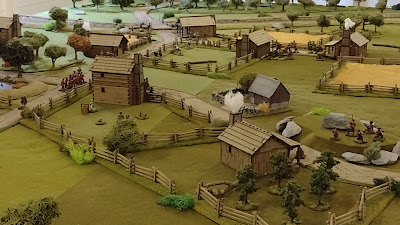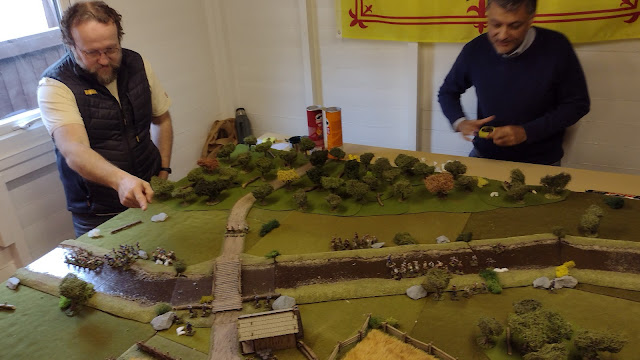Wednesday 30 March 2022
AHPC Final Update FFL in Algeria 1900 1903
Tuesday 29 March 2022
Battle of Mount Rock - French Indian War large scale skirmish in 28mm
The Setup & OOB
The British forces are a mix of Regulars, Light Infantry, provincials and civilians. They are dispersed across much of the table with the Line troops concentrated around the construction site for a new fort. They also have a unit of friendly Indians hiding in nearby woods. The French have a mixed force with Marines, Militia, Coureur de Bois and a sizable Indian contingent.
The British players (Myself, Ray and Mark) start the game not knowing where the French may attack from, and based on previous games, fully expecting to have to defend at various points around the table edge. I don't know if Stuart gave the French players (Steve & Surjit) much choice in deployment but they decided to attack with everything from one direction. The British had to wait a couple of turns to be absolutely sure that this was the only attack, before drawing reserves away from the other roads and this delay proved crucial for the outcome of the game.
 |
| The setup (picture gratefully borrowed from Ray's blog, Don't Throw a 1) |
The Action
 |
| French troops and Indians press forward sending British Militia and Civilians running for their lives. |
 |
| The 44th start to form up and move towards the battle, but having waited for two turns to be certain of the French attack, maybe it is too late? |
 |
| Formed up like this both lines can fire and with a bonus for volley fire...but only if they can get close enough to fire on the invaiders. |
 |
| The winners. Steve and Surjit after a well-deserved win. Steve's ability to roll hits was so impressive he won Man-of-the-Match, hence the happy look on his face. |
Conclusion
An excellent game, with some beautiful terrain and figures from Posties collection. As a British player, I was of course hoping for a different result, but the points at the end showed this as a clear win for the French, not least because they won the Initiative in all but one turn of the game.
Sunday 27 March 2022
No such thing as a bored wargamer
Sunday 20 March 2022
Lighting your paint Table
Thursday 17 March 2022
Maintaining the Blog: Change is Good
So following on from the videos that I put on my Miniature Adventures Channel I decided my blog was long overdue for a bit of TLC. Some of the widgets down the sidebar had stopped working, the Pages needed updating, and a friend of mine pointed out there wasn't even a 'Follow this Blog' button on my site. Much of this seems to have stemmed from the Theme Template I have been using. It worked a treat years ago when I started using it, but over time it has got more buggy and less user-friendly.
Thankfully changing to a new theme is a doddle in Blogger and after a little bit of personalisation, I have settled on the 'new' look for the blog. All the old content is still available and I have been able to bring back some of the widgets that had stopped working, including a proper Blogroll. I've even managed to add a 'Contact Me' form as I have had several people try to make contact via the Comments which can be a bit hit-and-miss.
There may be a few small changes over the next week or so, as I start to update and refresh some of the Pages which have been a little neglected. Once upon a time, you could only have ten pages, but now the sky is the limit, so I will be adding a few more with themed galleries of periods I collect or specific projects. I hope you like the new look and please, get in touch and let me know what you think.
Sunday 13 March 2022
Future of Wargame Blogging
Sunday 6 March 2022
Are Wargame Blogs Dying out
Tuesday 1 March 2022
The Battle of Le Champ Glissant
So I need to start this Battle Report with a huge apology. I was so invested in the game that I hardly shot any pictures and certainly didn't have time to make notes, so this is more like half of an AAR. That being said I did get a couple of cracking shots that I thought worth sharing and hopefully, Ray will have a fuller write up on his blog Don't Throw a One.
So this battle sees the action shift to the Lower Rhine (our earlier games took place in Italy) and the Austrian commander Archduke Charles has handled the Imperial army well, plays a careful game of manoeuvre with the French Army under General Moreau. The Austrians realise it is important to prevent a French breakthrough from the Rhine to the Danube and thus force an Austrian defeat. The French have however managed to bring about an engagement although the final position of the battle has yet to be determined (more on that in a moment).
The French meanwhile have been trying to fulfil the orders of the Directory and push the Austrians back to the Danube to link up with the Army of Italy. This would force the Austrian Emperor to make peace. Archduke Charles has been successfully avoiding a pitched engagement but now the French have finally brought him to battle.
The Pre Game Phase
Surjit and I took command of the French Army of the Rhine and for reasons completely unknown to myself, Surj trusted me with most of the troops in the centre of our line (I'm not known for my prowess with Napoleonic troops!). This effectively put me in charge as I would be taking on the bulk of the fighting and Surjits units had to coordinate with my attack. It has to be said we didn't necessarily know that when the game started because Richard introduced a clever mechanism for deployment and a chance to change the terrain, representing the two sides jockeying for position.
Both sides were given cards each representing a Brigade plus a couple of dummy cards. We then had to decide where to place these along our sector of the table edge. This done, both sides were then given another pack of cards with a range of options written on them. We each had to choose 12 cards from the deck and two sets were then shuffled into a 24 card deck. Three cards were then dealt with each side. Each turn of this 'probing phase' we drew an extra card from this deck and had to play one card from this set of four. The cards included things like: Placing a Farm or hill on the Tabke; Removing terrain items; moving terrain elements sideways or across the table; Moving units (we still didn't know which were real and which were blank at this stage). This continued until either one side had picked up two 'disadvantages', or both sides agreed to stop, or when the main deck had been used up. The result was that neither side had total control over the terrain or their own deployment.
With this phase over Richard then set up the Brigades where our unit cars indicated and both sides were then given a frantic ten minutes (and not a second longer!) to change formations or shift the orientation of units. The earlier phase meant that most of our units need up in a single 2ftx2ft square and it was so cramped it looked a bit like Picadilly Circus! We had a plan though, and so long as we didn't get our units muddled up, or hesitate with our moves, we were confident we could win the game.
The French Plan
So our plan was simple. Form as many units into Attack Columns as we could, with some regiments in skirmish formation to the front to shield the columns behind. Then we pointed ourselves at the enemy and marched as fast as our little french legs would carry us towards the Austrian line! Unfortunately where we were positioned necessitated a slight diagonal march to reach the part of the enemy line we wanted to hit but in the end, we only lost one turn of movement to get all our units aligned for a simultaneous attack.
My command was the main attack with five Regiments in attack column pointed at the centre of the Austrian line. Surjit was assigned to protect my right flank and I had some cavalry on my left that kept the Austrian flank sat in position for most of the game. Of course, no plan survives contact with the enemy and the Austrians were not idle in allowing us to do whatever we wanted. Initially, our plan worked, hitting the enemy in a coordinated attack that threw them back from their positions. The follow up was less well coordinated due to casualties and moral reductions...but I'm jumping ahead of myself a little.
The Austrian Plan
Well, it's hard to put words in their mouth but given the way they were deployed, I think it is fair to say they took a defensive posture from the start. Using a line of forest and hills (and some late-appearing wall) they lined up and dared the French to attack!
The Action
 |
| By the end of the second turn, my brigades were in a position to smash into the Austrian line. My Skirmish units had done their job and the attack columns behind were largely unscathed. |
 |
| A narrow French Victory. The points for melee's fought and casualties taken are a testament to the intensity of the fight in the centre of the line. |
 |
| Not sure if you can actually read this, but these are the Orders of Battle for both sides and the record of casualties taken. |




















